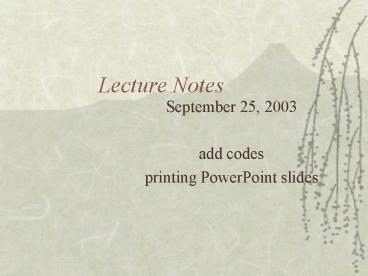Lecture Notes - PowerPoint PPT Presentation
1 / 13
Title:
Lecture Notes
Description:
Basic concepts National Income Accounting. The economy in the long run. Economic Fluctuations ... Do you suppose that's why they call it 'double-entry accounting' ... – PowerPoint PPT presentation
Number of Views:25
Avg rating:3.0/5.0
Title: Lecture Notes
1
Lecture Notes
- September 25, 2003
- add codes
- printing PowerPoint slides
2
Macroeconomics
- The economy as a whole
- Microeconomics individual buyer, firm, industry
- The economy as a whole from a micro point of
view general equilibrium theory - Macroeconomics is (somewhat) different
- aggregation deal with firms collectively,
- consumers collectively
- Reconciliation of macro, general equilibrium
assume individuals really are identical.
3
However ,
- For the purpose of this course, in a lot of
macro, we lose sight of micro altogether. - Example money.
- Question are there microeconomic foundations
for macro? Should there be? - If there are, its hard.
- Conclusion you should be thinking about the
relation between macro and micro - But it wont always be clear.
- Dont worry about it
4
Course Outline
- Basic concepts National Income Accounting
- The economy in the long run
- Economic Fluctuations
- Money
- International economy
5
National Income Accounting
- NIPA (National Income and Product Accounts)
- I may not tell you which chapters to read
- See course outline
- More detail than text.
6
Why are we interested in national income
accounting?
- To read the data
- But mostly to understand
- INCOME PRODUCT,
- SAVING INVESTMENT
7
Income statement vs. Balance sheet
- Income statement transactions related to
current production - Units dollars per unit of time (usually, per
year) - Flows, not Stocks
- GNP Gross National Product per year
- T-accounts on income statements, expenditures
on LHS, receipts on RHS - Expenditures what youre paying for purchases
of goods or productive services - Receipts what youre receiving
8
T-Accounts
9
Balance sheet
- Also a T-account
- But the column heads are Assets and Liabilities,
not Expenditures and Receipts - These are in units of , not per unit of time
- Stocks, not Flows
- Example a firms assets are its physical
capital its liabilities are bonds issued. - We dont deal with balance sheets here.
10
Transactions
- Only transactions related to current production
- Consider these transactions
- 1 firm, IBM, pays Jones 1000 in wages
- Jones buys 1 computer from IBM for 1000.
- Lets do the T-accounts corresponding to these
transactions.
11
(No Transcript)
12
Note
- Each transaction enters twice once as an
expenditure, once as a receipt. - Do you suppose thats why they call it
double-entry accounting? - (Of course, you are under no obligation to use
the same labels in both entries of a single
transaction).
13
Circular flow































